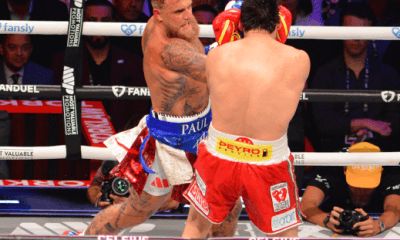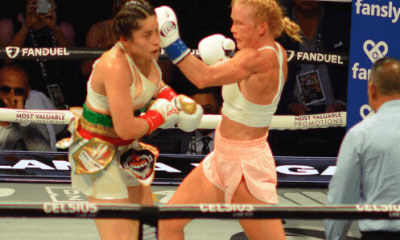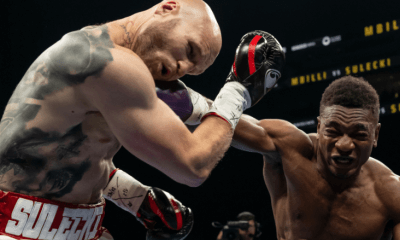Featured Articles
A Logbook of Boxers Behaving Badly…Really, Really Badly!

This isn’t about a fighter biting off part of his opponent’s ear, nor is it about saying, “no mas.” Those incidents have been well-vetted. This is about lesser known and in some cases more reprehensible incidents in which certain fighters behaved in a manner at odds with the standard set by the thousands of fighters who boxed before them.
Tony Anthony (1984) “The Blindside”
In November 1984, Detroit’s “The Fighting Schoolteacher,” Tony Anthony (16-2), took out heavy-handed Mike “Hercules” Weaver with a crunching left hook. A stunned Weaver sagged to the canvas like he had been sapped. The shocking ending came in a fight at the Riviera Hotel and Casino in Las Vegas. Mike was done. But then, so was “The Schoolteacher.”
The punch, which hit the defenseless Weaver in the back of the neck, landed after the bell had sounded ending round one as Weaver, having been dazed by a legal punch that landed at the bell, wandered back to the wrong corner. School ended early for Tony as he was summarily DQd. The stunned crowd hooted and howled as Tony lamely tried to explain that he did not hear the bell.
Some years later, the “Harlem Hammer,” James Butler, would take this scenario to a more horrific level when he slugged defenseless Richard Grant at the Roseland Ballroom in New York City.
The Harlem Hammer (2001) ”Cuff him!, Cuff him!, Cuff him!”
”He hasn’t been able to eat since the fight…I’ve never seen anyone get hit with a punch like this, blood squirting out of his mouth. He looked like he was dead.”— Promotor Jimmy Birchfield
One of the very worst losers in boxing history was James “The Harlem Hammer” Butler when he sucker-punched Richard Grant following their 10-round bout. The heavily bleeding Grant, who had just upset Butler, winning a unanimous decision, received 26 stitches, his jaw had been injured, he had some loose teeth and he later experienced severe headaches. Butler had used his bare hand.
As the crowd (with 500 police officials attending) chanted ”Cuff him!; cuff him!; cuff him!,” Butler was arrested and arraigned the next day on a second-degree assault charge for which he served four months in jail.
This was a precursor to a subsequent and unimaginable tragedy in 2004 in which Butler bludgeoned to death Sam Kellerman (brother of Max), a sportswriter who had befriended him. He murdered Kellerman with, yes, a hammer.
This entire sordid affair is one of the lowest points in boxing history with long-reaching implications. Every list has a “worst,” and this incident is it for this list.
Zab Judah (2001 and 2006) “It’s a Family Affair”
2001
When the undefeated and cocky Judah met the undefeated and humble Kostya Tszyu in November 2001, he said, “Tszyu’s style is made for me…He’s strong, stands up straight and comes forward. His style is like Swiss cheese – full of holes.” Unfortunately, Zab never had time to find those holes as Tszyu caught him with a perfect right hand in the second round and the famous “Chicken Dance” ensued, leading referee Jay Nady to waive it off. Zab then lost it (no pun intended) and went after Nady, first by throwing a stool at him and then holding his glove under Nady’s throat. It was uncomfortable for Nady and uncomfortable to witness.
2006
Later, Zab was involved is still another unseemly affair. In a fight tainted by a 10th-round brawl, Floyd Mayweather Jr. won a 12-round UD against Judah in April 2006 in Las Vegas in front of a near-sellout crowd of over 15,000 screaming fans. With seconds remaining in the 10th round, all hell erupted in the ring after Judah fouled Mayweather with a low blow. All of a sudden, it became a family affair. Mayweather’s trainer and uncle, former world champion boxer Roger Mayweather (who had predicted that something like this might occur) jumped in the ring and went after Judah. Zab’s father and trainer, Yoel Judah, then went into the ring from the other corner. Others also rushed into the ring before order was restored. Judah, his father, and Roger Mayweather were all fined and had their boxing licences revoked for one year.
Luis Alberto “El Mosquito” Lazarte (2012) “Riot Time in Argentina”
Lazarte had a record of 49-10-2 and was a former IBF light flyweight world champion when he took on the young Filipino John Riel Casimero with an interim world title at stake. However, four of his losses had come by way of disqualification, two in world title fights. Well known for his dirty tricks, Luis “El Mosquito” Lazarte was one dirty Mosquito and in this fight he reached a new level of loathsomeness.
“Lazarte tried to bully his way through Casimero’s defense from the start,” wrote Philippine Star reporter Joaquin Henson. “He bit the Filipino’s shoulder twice, butted, elbowed, threw rabbit punches and held his head down while belting out sucker blows. A point was deducted from Lazarte’s scorecard in the sixth for repeated butting.”
Casimero bent the rules too and didn’t help matters by gloating. In the ninth he knocked down Lazarte twice and was battering Lazarte in the 10th when the referee Eddie Claudio stopped the fight. This ignited a full-scale riot. Here’s how Dan Rafael reported it: “As (Claudio) was stopping the bout, spectators at ringside began throwing debris into the ring and eventually it became a full-scale riot — the worst boxing has seen since one erupted at New York’s Madison Square Garden in 1996 after heavyweight Andrew Golota was disqualified for repeatedly hitting Riddick Bowe below the belt in the first of their two fights.”
This ugly scene, which is on You Tube, has to be seen to be believed. The liquored-up pro- Lazarte crowd went bonkers and threw drinks, empty bottles, scores of chairs, chains, and other debris into the ring hitting Casimero and his cornermen who then wisely hid under the ring for some 30 minutes. It seemed like every chair in the house was in the ring.
Worse than his infractions was what “El Mosquito” said to Claudio as he was being deducted a point in the sixth round: “Do you want to make it out of here alive?”
Later IBF President Daryl Peoples wrote “There is one measure that we are taking into our own hands and that we will enforce,…As a result of Luis Lazarte threatening the life of referee Eddie Claudio while receiving a points deduction in the sixth round, Lazarte is banned from being involved in any capacity in any IBF-related fight that takes place in Argentina or around the world.” But like many suspensions this one last only 29 months. El Mosquito fought four more times before retiring in 2015 with a 52-12-2 record–and a likely place in Boxing’s Virtual Hall of Shame.
Andrew Golota (1992-2013) “Boxing is 10% Physical and 90% Mental,”
Headbutting, biting and elbowing, the Pole from Chicago by way of Warsaw became known as the “The Foul Pole” and actually became a serial quitter of sorts as he took the DQ route against Riddick Bowe twice and quit against Michael Grant and Mike Tyson. Mental meltdowns were not uncommon for this man who possessed solid talent (41-9-1) that he went and squandered with his lack of stability in the ring. When someone says “boxing is 10% physical and 90% mental,” Golota quickly comes to mind.
“Vicious” Victor Ortiz also comes to mind given his documented serial-like propensity to quit.
Juan Manuel Lopez (2012) “Accident Waiting to Happen”
Juanma’s post fight behavior, winning or losing, has been bizarre on more than one occasion. However, after he lost in a tremendous battle with Orlando “Siri” Salido for the second time, a groggy Lopez whined during the post-fight interview and accused referee Roberto Ramirez and his son Roberto Ramirez Jr (who was the third man for the first Salido-Lopez fight) of having gambling problems. (Of course, he might still have been on Queer Street while being interviewed by the ever-opportunistic Jim Gray.)
Gray went on to induction into the IBHOF while the often concussed Lopez remains a possible accident waiting to happen if he continues to box.
Can you think of other really bad losers?
Ted Sares is one of the world’s oldest active power lifters and Strongman competitors and plans to compete in at least three events in 2019. He is a lifetime member of Ring 10, and a member of Ring 4 and its Boxing Hall of Fame. He also is an Auxiliary Member of the Boxing Writers Association of America (BWAA).
Check out more boxing news on video at The Boxing Channel
To comment on this article in The Fight Forum CLICK HERE
-

 Featured Articles3 weeks ago
Featured Articles3 weeks agoAvila Perspective, Chap. 330: Matchroom in New York plus the Latest on Canelo-Crawford
-

 Featured Articles1 week ago
Featured Articles1 week agoVito Mielnicki Jr Whitewashes Kamil Gardzielik Before the Home Folks in Newark
-

 Featured Articles4 weeks ago
Featured Articles4 weeks agoAvila Perspective, Chap 329: Pacquiao is Back, Fabio in England and More
-

 Featured Articles3 weeks ago
Featured Articles3 weeks agoOpetaia and Nakatani Crush Overmatched Foes, Capping Off a Wild Boxing Weekend
-

 Featured Articles2 weeks ago
Featured Articles2 weeks agoCatching Up with Clay Moyle Who Talks About His Massive Collection of Boxing Books
-

 Featured Articles3 weeks ago
Featured Articles3 weeks agoFabio Wardley Comes from Behind to KO Justis Huni
-

 Featured Articles1 week ago
Featured Articles1 week agoMore Medals for Hawaii’s Patricio Family at the USA Boxing Summer Festival
-

 Featured Articles4 weeks ago
Featured Articles4 weeks agoDelving into ‘Hoopla’ with Notes on Books by George Plimpton and Joyce Carol Oates





















